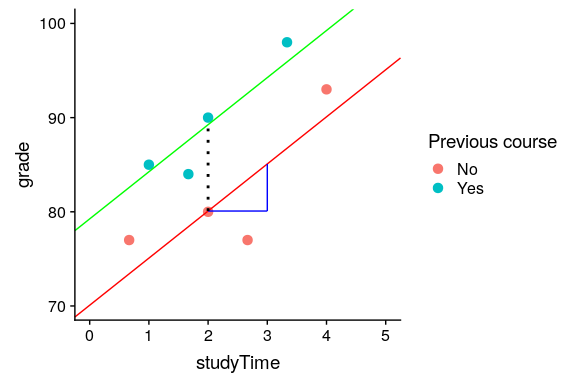## 14.2 安裝更復雜的模型
我們通常希望了解多個變量對某些特定結果的影響,以及它們如何相互關聯。在我們學習時間的例子中,假設我們發現一些學生以前參加過關于這個主題的課程。如果我們繪制他們的成績(見圖[14.4](#fig:StudytimeGradesPrior)),我們可以看到,在相同的學習時間內,那些上過一門課的學生比沒有上過課的學生表現要好得多。

圖 14.4 學習時間和成績之間的關系,顏色標識每個學生是否上過該主題的課程
我們希望建立一個考慮到這一點的統計模型,我們可以通過擴展我們在上面建立的模型來實現這一點:

為了模擬每個人是否有以前的類,我們使用我們稱之為 _ 的偽編碼 _ 來創建一個新變量,該變量的值為 1 表示以前有過一個類,否則為零。這意味著,對于以前上過課的人,我們只需將的值添加到他們的預測值中——也就是說,使用虛擬編碼只是反映了兩組人之間的平均值差異。我們對的估計反映了所有數據點的回歸斜率——我們假設回歸斜率是相同的,不管以前是否有過類(見圖[14.5](#fig:LinearRegressionByPriorClass))。
```r
# perform linear regression for study time and prior class
# must change priorClass to a factor variable
df$priorClass <- as.factor(df$priorClass)
lmResultTwoVars <- lm(grade ~ studyTime + priorClass, data = df)
summary(lmResultTwoVars)
```
```r
##
## Call:
## lm(formula = grade ~ studyTime + priorClass, data = df)
##
## Residuals:
## 1 2 3 4 5 6 7 8
## 3.5833 0.7500 -3.5833 -0.0833 0.7500 -6.4167 2.0833 2.9167
##
## Coefficients:
## Estimate Std. Error t value Pr(>|t|)
## (Intercept) 70.08 3.77 18.60 8.3e-06 ***
## studyTime 5.00 1.37 3.66 0.015 *
## priorClass1 9.17 2.88 3.18 0.024 *
## ---
## Signif. codes: 0 '***' 0.001 '**' 0.01 '*' 0.05 '.' 0.1 ' ' 1
##
## Residual standard error: 4 on 5 degrees of freedom
## Multiple R-squared: 0.803, Adjusted R-squared: 0.724
## F-statistic: 10.2 on 2 and 5 DF, p-value: 0.0173
```

圖 14.5 研究時間和年級之間的關系,包括作為模型中額外組成部分的先前經驗。藍線表示與學習時間相關的坡度,黑色虛線表示兩組之間平均值的差異。
- 前言
- 0.1 本書為什么存在?
- 0.2 你不是統計學家-我們為什么要聽你的?
- 0.3 為什么是 R?
- 0.4 數據的黃金時代
- 0.5 開源書籍
- 0.6 確認
- 1 引言
- 1.1 什么是統計思維?
- 1.2 統計數據能為我們做什么?
- 1.3 統計學的基本概念
- 1.4 因果關系與統計
- 1.5 閱讀建議
- 2 處理數據
- 2.1 什么是數據?
- 2.2 測量尺度
- 2.3 什么是良好的測量?
- 2.4 閱讀建議
- 3 概率
- 3.1 什么是概率?
- 3.2 我們如何確定概率?
- 3.3 概率分布
- 3.4 條件概率
- 3.5 根據數據計算條件概率
- 3.6 獨立性
- 3.7 逆轉條件概率:貝葉斯規則
- 3.8 數據學習
- 3.9 優勢比
- 3.10 概率是什么意思?
- 3.11 閱讀建議
- 4 匯總數據
- 4.1 為什么要總結數據?
- 4.2 使用表格匯總數據
- 4.3 分布的理想化表示
- 4.4 閱讀建議
- 5 將模型擬合到數據
- 5.1 什么是模型?
- 5.2 統計建模:示例
- 5.3 什么使模型“良好”?
- 5.4 模型是否太好?
- 5.5 最簡單的模型:平均值
- 5.6 模式
- 5.7 變異性:平均值與數據的擬合程度如何?
- 5.8 使用模擬了解統計數據
- 5.9 Z 分數
- 6 數據可視化
- 6.1 數據可視化如何拯救生命
- 6.2 繪圖解剖
- 6.3 使用 ggplot 在 R 中繪制
- 6.4 良好可視化原則
- 6.5 最大化數據/墨水比
- 6.6 避免圖表垃圾
- 6.7 避免數據失真
- 6.8 謊言因素
- 6.9 記住人的局限性
- 6.10 其他因素的修正
- 6.11 建議閱讀和視頻
- 7 取樣
- 7.1 我們如何取樣?
- 7.2 采樣誤差
- 7.3 平均值的標準誤差
- 7.4 中心極限定理
- 7.5 置信區間
- 7.6 閱讀建議
- 8 重新采樣和模擬
- 8.1 蒙特卡羅模擬
- 8.2 統計的隨機性
- 8.3 生成隨機數
- 8.4 使用蒙特卡羅模擬
- 8.5 使用模擬統計:引導程序
- 8.6 閱讀建議
- 9 假設檢驗
- 9.1 無效假設統計檢驗(NHST)
- 9.2 無效假設統計檢驗:一個例子
- 9.3 無效假設檢驗過程
- 9.4 現代環境下的 NHST:多重測試
- 9.5 閱讀建議
- 10 置信區間、效應大小和統計功率
- 10.1 置信區間
- 10.2 效果大小
- 10.3 統計能力
- 10.4 閱讀建議
- 11 貝葉斯統計
- 11.1 生成模型
- 11.2 貝葉斯定理與逆推理
- 11.3 進行貝葉斯估計
- 11.4 估計后驗分布
- 11.5 選擇優先權
- 11.6 貝葉斯假設檢驗
- 11.7 閱讀建議
- 12 分類關系建模
- 12.1 示例:糖果顏色
- 12.2 皮爾遜卡方檢驗
- 12.3 應急表及雙向試驗
- 12.4 標準化殘差
- 12.5 優勢比
- 12.6 貝葉斯系數
- 12.7 超出 2 x 2 表的分類分析
- 12.8 注意辛普森悖論
- 13 建模持續關系
- 13.1 一個例子:仇恨犯罪和收入不平等
- 13.2 收入不平等是否與仇恨犯罪有關?
- 13.3 協方差和相關性
- 13.4 相關性和因果關系
- 13.5 閱讀建議
- 14 一般線性模型
- 14.1 線性回歸
- 14.2 安裝更復雜的模型
- 14.3 變量之間的相互作用
- 14.4“預測”的真正含義是什么?
- 14.5 閱讀建議
- 15 比較方法
- 15.1 學生 T 考試
- 15.2 t 檢驗作為線性模型
- 15.3 平均差的貝葉斯因子
- 15.4 配對 t 檢驗
- 15.5 比較兩種以上的方法
- 16 統計建模過程:一個實例
- 16.1 統計建模過程
- 17 做重復性研究
- 17.1 我們認為科學應該如何運作
- 17.2 科學(有時)是如何工作的
- 17.3 科學中的再現性危機
- 17.4 有問題的研究實踐
- 17.5 進行重復性研究
- 17.6 進行重復性數據分析
- 17.7 結論:提高科學水平
- 17.8 閱讀建議
- References
